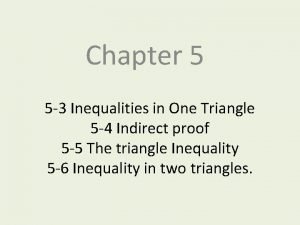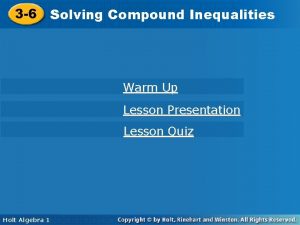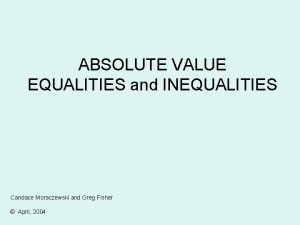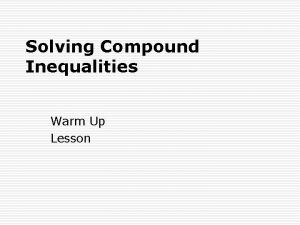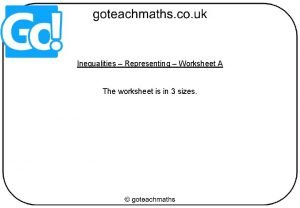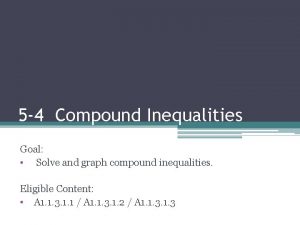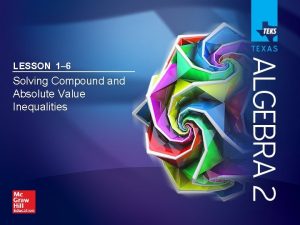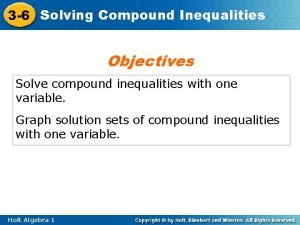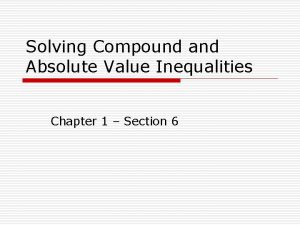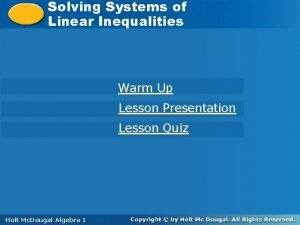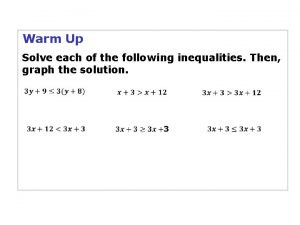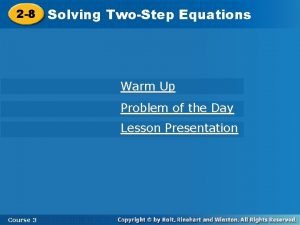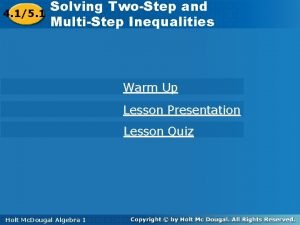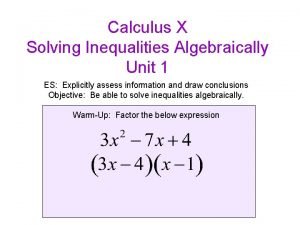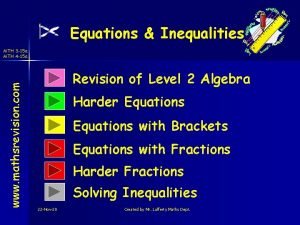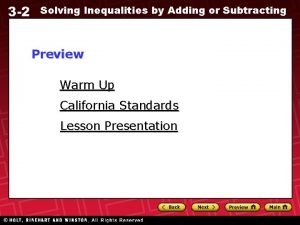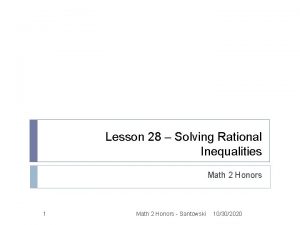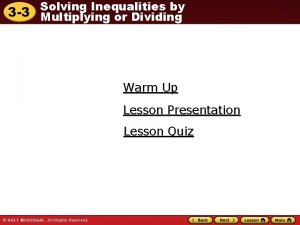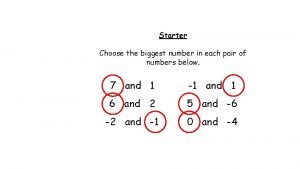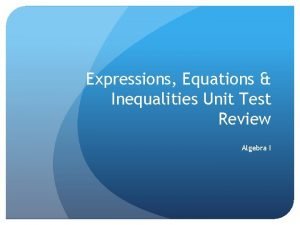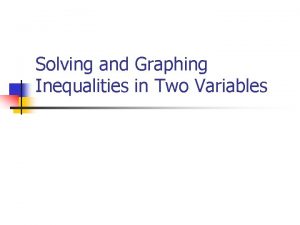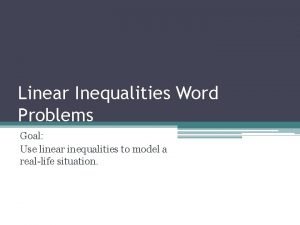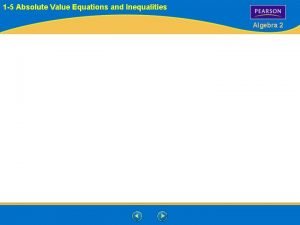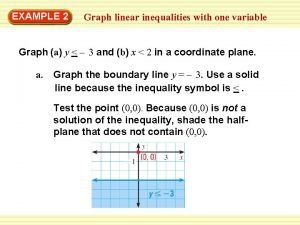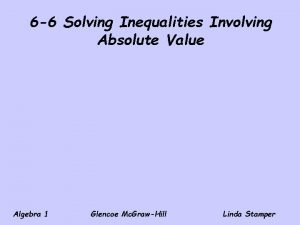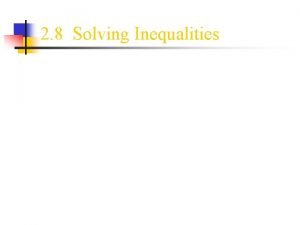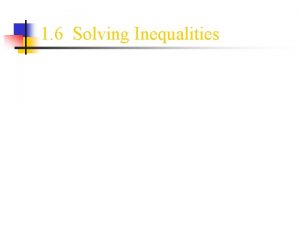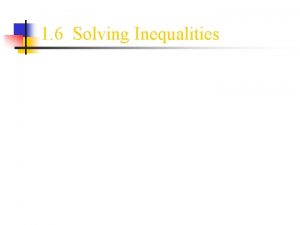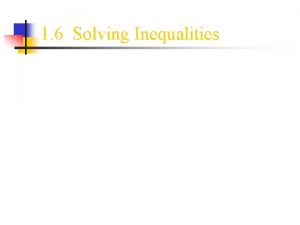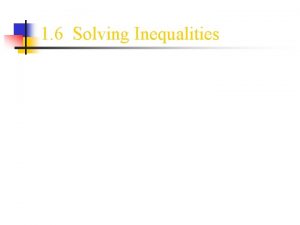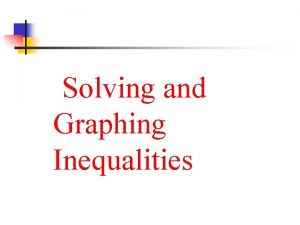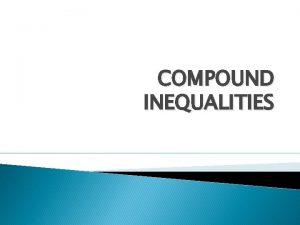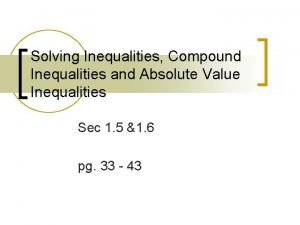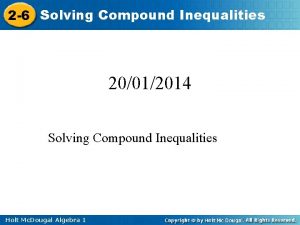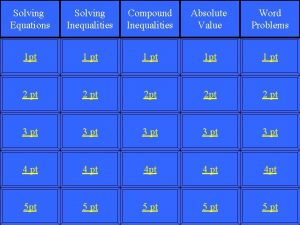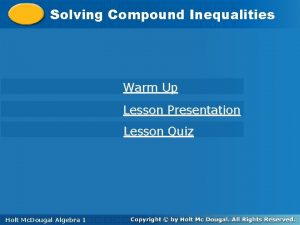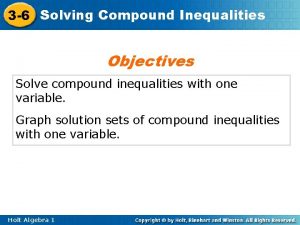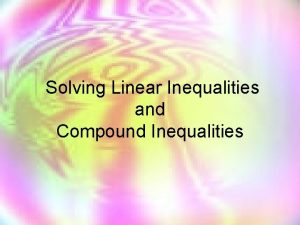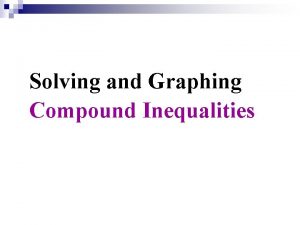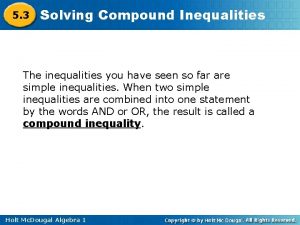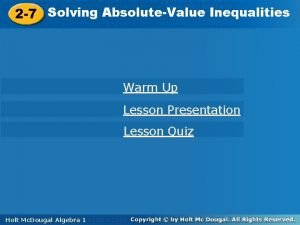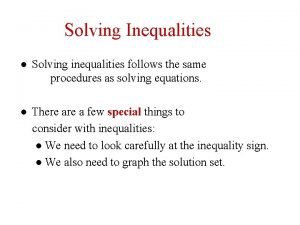3 6 Solving Compound Inequalities 3 6 Warm





























- Slides: 29

3 -6 Solving. Compound. Inequalities 3 -6 Warm Up Lesson Presentation Lesson Quiz Holt Algebra 11 Holt Algebra

3 -6 Solving Compound Inequalities Warm Up Solve each inequality. 1. x + 3 ≤ 10 x ≤ 7 2. 23 < – 2 x + 3 – 10 > x Solve each inequality and graph the solutions. 4. 4 x + 1 ≤ 25 x ≤ 6 5. 0 ≥ 3 x + 3 – 1 ≥ x Holt Algebra 1

3 -6 Solving Compound Inequalities Objectives Solve compound inequalities with one variable. Graph solution sets of compound inequalities with one variable. Holt Algebra 1

3 -6 Solving Compound Inequalities Vocabulary compound inequality intersection union Holt Algebra 1

3 -6 Solving Compound Inequalities The inequalities you have seen so far are simple inequalities. When two simple inequalities are combined into one statement by the words AND or OR, the result is called a compound inequality. Holt Algebra 1

3 -6 Solving Compound Inequalities Holt Algebra 1

3 -6 Solving Compound Inequalities Example 1: Chemistry Application The p. H level of a popular shampoo is between 6. 0 and 6. 5 inclusive. Write a compound inequality to show the p. H levels of this shampoo. Graph the solutions. Let p be the p. H level of the shampoo. 6. 0 is less than or equal to p. H level is less than or equal to 6. 5 6. 0 ≤ p ≤ 6. 5 5. 9 6. 0 Holt Algebra 1 6. 2 6. 3 6. 4 6. 5

3 -6 Solving Compound Inequalities Check It Out! Example 1 The free chlorine in a pool should be between 1. 0 and 3. 0 parts per million inclusive. Write a compound inequality to show the levels that are within this range. Graph the solutions. Let c be the chlorine level of the pool. 1. 0 is less than or equal to 1. 0 chlorine ≤ is less than or equal to c ≤ 1. 0 ≤ c ≤ 3. 0 0 Holt Algebra 1 1 2 3 4 5 6 3. 0

3 -6 Solving Compound Inequalities In this diagram, oval A represents some integer solutions of x < 10 and oval B represents some integer solutions of x > 0. The overlapping region represents numbers that belong in both ovals. Those numbers are solutions of both x < 10 and x > 0. Holt Algebra 1

3 -6 Solving Compound Inequalities You can graph the solutions of a compound inequality involving AND by using the idea of an overlapping region. The overlapping region is called the intersection and shows the numbers that are solutions of both inequalities. Holt Algebra 1

3 -6 Solving Compound Inequalities Example 2 A: Solving Compound Inequalities Involving AND Solve the compound inequality and graph the solutions. – 5 < x + 1 < 2 Since 1 is added to x, subtract 1 from each part of the inequality. – 5 < x + 1 < 2 – 1– 1 – 6 < x < 1 Graph – 6 < x. – 10 – 8 – 6 – 4 – 2 Holt Algebra 1 0 2 4 6 8 10 Graph x < 1. Graph the intersection by finding where the two graphs overlap.

3 -6 Solving Compound Inequalities Example 2 B: Solving Compound Inequalities Involving AND Solve the compound inequality and graph the solutions. 8 < 3 x – 1 ≤ 11 +1 +1 +1 9 < 3 x ≤ 12 3<x≤ 4 Holt Algebra 1 Since 1 is subtracted from 3 x, add 1 to each part of the inequality. Since x is multiplied by 3, divide each part of the inequality by 3 to undo the multiplication.

3 -6 Solving Compound Inequalities Example 2 B Continued Graph 3 < x. Graph x ≤ 4. – 5 – 4 – 3 – 2 – 1 Holt Algebra 1 0 1 2 3 4 5 Graph the intersection by finding where the two graphs overlap.

3 -6 Solving Compound Inequalities Check It Out! Example 2 a Solve the compound inequality and graph the solutions. – 9 < x – 10 < – 5 +10 +10 1<x<5 Since 10 is subtracted from x, add 10 to each part of the inequality. Graph 1 < x. Graph x < 5. – 5 – 4 – 3 – 2 – 1 Holt Algebra 1 0 1 2 3 4 5 Graph the intersection by finding where the two graphs overlap.

3 -6 Solving Compound Inequalities Check It Out! Example 2 b Solve the compound inequality and graph the solutions. – 4 ≤ 3 n + 5 < 11 – 5 – 5 – 9 ≤ 3 n < Since 5 is added to 3 n, subtract 5 from each part of the inequality. Since n is multiplied by 3, divide each part of the inequality by 3 to undo the multiplication. 6 – 3 ≤ n < 2 Graph – 3 ≤ n. Graph n < 2. – 5 – 4 – 3 – 2 – 1 Holt Algebra 1 0 1 2 3 4 5 Graph the intersection by finding where the two graphs overlap.

3 -6 Solving Compound Inequalities In this diagram, circle A represents some integer solutions of x < 0, and circle B represents some integer solutions of x > 10. The combined shaded regions represent numbers that are solutions of either x < 0 or x >10. Holt Algebra 1

3 -6 Solving Compound Inequalities You can graph the solutions of a compound inequality involving OR by using the idea of combining regions. The combine regions are called the union and show the numbers that are solutions of either inequality. > Holt Algebra 1

3 -6 Solving Compound Inequalities Example 3 A: Solving Compound Inequalities Involving OR Solve the inequality and graph the solutions. 8 + t ≥ 7 OR 8 + t < 2 – 8 – 8 − 8 t ≥ – 1 OR t < – 6 Solve each simple inequality. Graph t ≥ – 1. Graph t < – 6. – 10 – 8 – 6 – 4 – 2 Holt Algebra 1 0 2 4 6 8 10 Graph the union by combining the regions.

3 -6 Solving Compound Inequalities Example 3 B: Solving Compound Inequalities Involving OR Solve the inequality and graph the solutions. 4 x ≤ 20 OR 3 x > 21 Solve each simple inequality. x ≤ 5 OR x > 7 Graph x ≤ 5. Graph x > 7. – 10 – 8 – 6 – 4 – 2 Holt Algebra 1 0 2 4 6 8 10 Graph the union by combining the regions.

3 -6 Solving Compound Inequalities Check It Out! Example 3 a Solve the compound inequality and graph the solutions. 2 +r < 12 OR r + 5 > 19 – 2 – 5 Solve each simple inequality. r < 10 OR r > 14 Graph r < 10. Graph r > 14. – 4 – 2 0 Holt Algebra 1 2 4 6 8 10 12 14 16 Graph the union by combining the regions.

3 -6 Solving Compound Inequalities Check It Out! Example 3 b Solve the compound inequality and graph the solutions. 7 x ≥ 21 OR 2 x < – 2 x≥ 3 OR Solve each simple inequality. x < – 1 Graph x ≥ 3. – 5 – 4 – 3 – 2 – 1 Holt Algebra 1 0 1 2 3 4 5 Graph x < − 1. Graph the union by combining the regions.

3 -6 Solving Compound Inequalities Every solution of a compound inequality involving AND must be a solution of both parts of the compound inequality. If no numbers are solutions of both simple inequalities, then the compound inequality has no solutions. The solutions of a compound inequality involving OR are not always two separate sets of numbers. There may be numbers that are solutions of both parts of the compound inequality. Holt Algebra 1

3 -6 Solving Compound Inequalities Example 4 A: Writing a Compound Inequality from a Graph Write the compound inequality shown by the graph. The shaded portion of the graph is not between two values, so the compound inequality involves OR. On the left, the graph shows an arrow pointing left, so use either < or ≤. The solid circle at – 8 means – 8 is a solution so use ≤. x ≤ – 8 On the right, the graph shows an arrow pointing right, so use either > or ≥. The empty circle at 0 means that 0 is not a solution, so use >. x > 0 The compound inequality is x ≤ – 8 OR x > 0. Holt Algebra 1

3 -6 Solving Compound Inequalities Example 4 B: Writing a Compound Inequality from a Graph Write the compound inequality shown by the graph. The shaded portion of the graph is between the values – 2 and 5, so the compound inequality involves AND. The shaded values are on the right of – 2, so use > or ≥. The empty circle at – 2 means – 2 is not a solution, so use >. m > – 2 The shaded values are to the left of 5, so use < or ≤. The empty circle at 5 means that 5 is not a solution so use <. m<5 The compound inequality is m > – 2 AND m < 5 (or -2 < m < 5). Holt Algebra 1

3 -6 Solving Compound Inequalities Check It Out! Example 4 a Write the compound inequality shown by the graph. The shaded portion of the graph is between the values – 9 and – 2, so the compound inequality involves AND. The shaded values are on the right of – 9, so use > or . The empty circle at – 9 means – 9 is not a solution, so use >. x > – 9 The shaded values are to the left of – 2, so use < or ≤. The empty circle at – 2 means that – 2 is not a solution so use <. x < – 2 The compound inequality is – 9 < x AND x < – 2 (or – 9 < x < – 2). Holt Algebra 1

3 -6 Solving Compound Inequalities Check It Out! Example 4 b Write the compound inequality shown by the graph. The shaded portion of the graph is not between two values, so the compound inequality involves OR. On the left, the graph shows an arrow pointing left, so use either < or ≤. The solid circle at – 3 means – 3 is a solution, so use ≤. x ≤ – 3 On the right, the graph shows an arrow pointing right, so use either > or ≥. The solid circle at 2 means that 2 is a solution, so use ≥. x ≥ 2 The compound inequality is x ≤ – 3 OR x ≥ 2. Holt Algebra 1

3 -6 Solving Compound Inequalities Lesson Quiz: Part I 1. The target heart rate during exercise for a 15 year-old is between 154 and 174 beats per minute inclusive. Write a compound inequality to show the heart rates that are within the target range. Graph the solutions. 154 ≤ h ≤ 174 Holt Algebra 1

3 -6 Solving Compound Inequalities Lesson Quiz: Part II Solve each compound inequality and graph the solutions. 2. 2 ≤ 2 w + 4 ≤ 12 – 1 ≤ w ≤ 4 3. 3 + r > − 2 OR 3 + r < − 7 r > – 5 OR r < – 10 Holt Algebra 1

3 -6 Solving Compound Inequalities Lesson Quiz: Part III Write the compound inequality shown by each graph. 4. x < − 7 OR x ≥ 0 5. − 2 ≤ a < 4 Holt Algebra 1
 Inequalities in one triangle
Inequalities in one triangle Compound inequalities example
Compound inequalities example Lesson 3-3 compound inequalities
Lesson 3-3 compound inequalities 1-6 solving compound and absolute value inequalities
1-6 solving compound and absolute value inequalities 5-4 solving compound inequalities
5-4 solving compound inequalities Graphing inequalities worksheet
Graphing inequalities worksheet 5-4 compound inequalities
5-4 compound inequalities Lesson 1-6 solving compound and absolute value inequalities
Lesson 1-6 solving compound and absolute value inequalities 3-6 compound inequalities
3-6 compound inequalities A pair of inequalities joined by and or or
A pair of inequalities joined by and or or Lesson 1-6 compound inequalities
Lesson 1-6 compound inequalities 2-1 graphing and writing inequalities
2-1 graphing and writing inequalities Inequalities warm up
Inequalities warm up The dance committee hired a dj for the fall dance
The dance committee hired a dj for the fall dance Solving equations warm up
Solving equations warm up Two step linear inequalities
Two step linear inequalities Solving inequalities calculus
Solving inequalities calculus Solving equations and inequalities
Solving equations and inequalities Adding inequalities
Adding inequalities Rational inequalities examples with answers
Rational inequalities examples with answers 3-3 solving inequalities by multiplication or division
3-3 solving inequalities by multiplication or division Solve each system of inequalities by graphing
Solve each system of inequalities by graphing Radical equations and inequalities
Radical equations and inequalities Solving linear inequalities hangman answers
Solving linear inequalities hangman answers 1.18 unit test solving inequalities - part 1
1.18 unit test solving inequalities - part 1 Linear inequalities in two variables calculator
Linear inequalities in two variables calculator Inequalities word problem
Inequalities word problem Lesson 1-5 solving equations and inequalities by graphing
Lesson 1-5 solving equations and inequalities by graphing Linear inequalities example
Linear inequalities example Solve the inequality involving absolute value
Solve the inequality involving absolute value
